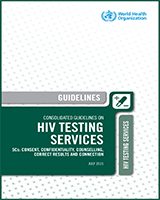| Random sequence generation (selection bias)? | Low risk | “Because it has been shown that HIV test acceptance is affected by sex and age,18 we randomized USHER study participants into 4 strata (i.e., men <40 years, men ≥40 years, women <40 years, and women >40 years) and performed computer generated block randomisation (with blocks of variable size) within each stratum.” (p. 3) |
| Allocation concealment (selection bias)? | Low/uncertain risk | Method of concealment is partially described, but exact procedures unclear. “Data center personnel are responsible for providing the research assistant with the computer-generated random assignment schema, with arm assignment within each stratum.” (appendix) |
| Blinding of participants and personnel (performance bias)? | High risk | Participants and personnel were not blinded, and lack of blinding could influence the outcome. “Subjects, counselors, and providers were neither masked to the assigned arms nor incentivised to complete the testing process.” (p. 3) However, blinding for this intervention (lay providers vs. health care providers) would be difficult, if not impossible. |
| Blinding of outcome assessment (detection bias)? | Low risk | Outcome assessment was not blinded, but lack of blinding should not influence the outcome (HTS uptake). Data analysis was blinded. “Data analysis, however, occurred with patients' identification numbers only; investigators were not aware of each patient's assignment.” (appendix) |
| Incomplete outcome data (attrition bias)? | Low risk | No missing data reported (number randomized equal to the number for whom outcomes are reported) |
| Selective reporting (reporting bias)? | Uncertain risk | Insufficient information to assess high risk or low risk. (Some protocol details available in appendix, but no clear mention of pre-specified outcomes. However, presented outcomes seem likely to be the originally specified outcomes.) |
| Other bias? | Low risk | The study appears to be free of other sources of bias. |
